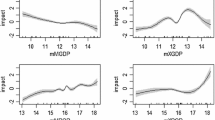Abstract
A theoretical foundation for predicting the distribution of trade strength and the rate of change of trade strength was developed. These two quantities were found to satisfy the Pareto distribution function. The equations were confirmed using data from the World Integrated Trade Solution and the World Bank by comparing the Akaike information criterion and Bayesian information criterion to five types of distribution functions (exponential, lognormal, gamma, Pareto, and Weibull). Furthermore, the fitted Pareto power parameter is quite similar to the theoretical prediction. The developed distribution function is expected to be useful in forecasting international trade in countries and global economics, enabling the implementation of optimal policies.




Similar content being viewed by others
Data Availability
Data will be made available on request.
References
Abdullah, M. (2023). A new approach to overcoming zero trade in gravity models for international trade to avoid indefinite values in linear logarithmic equations and parameter verification using machine learning. Cornell University. (Retrieved August 30, 2023. Preprint at https://arxiv.org/abs/2308.06303)
Akaike, H. (1998). Information theory and an extension of the maximum likelihood principleIn E. Parzen, K. Tanabe, & G. Kitagawa (Eds.), Selected papers of Hirotugu Akaike. Springer Series in Statistics. New York, NY: Springer. https://doi.org/10.1007/978-1-4612-1694-0_15
Bourguignon, M., Gallardo, D. I., & Gómez, H. J. (2022). A Note on Pareto-type distributions parameterized by its mean and precision parameters. Mathematics, 10(3), 528. https://doi.org/10.3390/math10030528
Chandrasekhar, S., & von Neumann, J. (1942). The statistics of the gravitational field arising from a random distribution of stars. I. The speed of fluctuations. The Astrophysical Journal, 95(3), 489–531.
Chaney, T. (2018). The gravity equation in international trade: An explanation. Journal of Political Economy, 126(1), 150–177.
Claeskens, G., & Hjort, N. L. (2008). Model Selection and Model Averaging. Cambridge University Press.
Navarrete, A. F. C., & Tatlonhari, V. M. (2018). An empirical assessment of the effects of the Japan-Philippine Economic Partnership Agreement (JPEPA) on Philippine exports to Japan: a gravity model approach. Journal of Economic Structures, 2018(7), 31. https://doi.org/10.1186/s40008-018-0129-8
Nijkamp, P., & Ratajczak, W. (2021). Gravitational analysis in regional science and spatial economics: A vector gradient approach to trade. International Regional Science Review, 44(3–4), 400–431.
Santos Silva, J. M. C., & Tenreyro, S. (2006). The log of gravity. The Review of Economics and Statistics, 88(4), 641–658.
Statista. (2023). Empowering people with data. (Retrieved January 10, 2023, from https://www.statista.com/)
Tanabe, K. (2018). Pareto’s 80/20 rule and the Gaussian distribution. Physica A: Statistical Mechanics and its Applications, 510(November), 635–640.
Tinbergen, J. (1966). Shaping the world economy: suggestions for an international economic policy. The Economic Journal, 76(301), 92–95.
Umargono, E., Suseno, J. E., & Gunawan, S. K. V. (2020). K-Means clustering optimization using the elbow method and early centroid determination based on mean and median formula, Proceedings of the 2nd International Seminar on Science and Technology (ISSTEC 2019), 121–129. Retrieved March 15, 2023, from https://www.atlantis-press.com/proceedings/isstec-19/125944915
WITS. (2022). Trade statistics by Country/Region. (Retrieved July 5, 2022, from https://wits.worldbank.org/countrystats.aspx?lang=en)
World Bank. (2022). GDP (current US$). (Retrieved June 10, 2022, from https://data.worldbank.org/indicator/NY.GDP.MKTP.CD)
World Bank. (2023). GDP growth (annual %). (Retrieved April 1, 2023, from https://data.worldbank.org/indicator/NY.GDP.MKTP.KD.ZG)
Author information
Authors and Affiliations
Corresponding author
Additional information
Publisher's Note
Springer Nature remains neutral with regard to jurisdictional claims in published maps and institutional affiliations.
Supplementary Information
Below is the link to the electronic supplementary material.
Rights and permissions
Springer Nature or its licensor (e.g. a society or other partner) holds exclusive rights to this article under a publishing agreement with the author(s) or other rightsholder(s); author self-archiving of the accepted manuscript version of this article is solely governed by the terms of such publishing agreement and applicable law.
About this article
Cite this article
Abdullah, M. Theoretical Foundation for the Pareto Distribution of International Trade Strength and Introduction of an Equation for International Trade Forecasting. Atl Econ J 52, 17–29 (2024). https://doi.org/10.1007/s11293-024-09790-3
Accepted:
Published:
Issue Date:
DOI: https://doi.org/10.1007/s11293-024-09790-3




